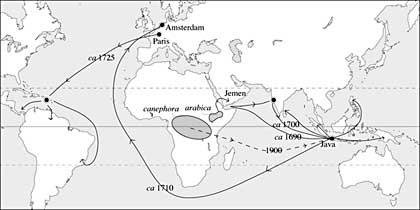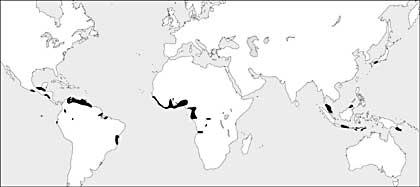Uses of plants: stimulating drinks
However, in different cultures the uses of plants are similar, each culture is based on native plants. Feeding (fruits, roots, etc.) is, in general, the part that all groups want to cover. through), drinks (stimulants and alcoholics), handicrafts (wood, bamboo, ...), textiles (clothes, sacks, ...), medicine (medicinal plants and drugs, ...).
The plants selected by society over the years have been numerous. Vegetables can be used at different levels. Some, in their totality or taking advantage of a specific part, with little industrial processes. On other occasions, it must endure a long production or industrial process, forgetting its origin.
Given that the donation of the list of plants educated in different times could be extended, figure 1 shows the most important plants produced in different territories.

Since different cultures have had their own development, the current level is also different. The West, for example, has undergone a spectacular industrialization process, after which traditional uses have been modified. Moreover, with industrialization there has been a globalization of the economy in which, almost forgotten of its origin, the transports and movements of the products are deducted.
As we have said, the uses of plants are many, and since all of them are of economic importance, the aim of this article is no other than to underline the importance of plants in our society, but it is also to cite the history and biology of some products. We will indicate how plants have been used in the processes of stimulating drinks.
Chocolate (cocoa), coffee and tea, which are currently consumed as daily drinks, are stimulating drinks, and others such as malt, cola and guarana, of lesser importance.
The common feature of these drinks is the presence of caffeine or its derivatives, which produces physiological reactions such as activating circulation, accelerating the heart, etc. However, in excess it produces burukomine, lack of sleep and tachycardia. It is evident that stimulating drinks have become a human drug.
CAFÉ CAFÉ
Family Coffea Arabica, C. canephora Rubiaceae
Besides oil, it is one of the most important products in the market and at the same time the first of the stimulating drinks. The most cultivated species (C. arabica) has its origin in the Egyptian mountains (1,500-2,000 m.), but the one cultivated in Africa is the other species, C. canephora.
The first use of this plant was the mastication of leaves and seeds, to subsequently reduce fatigue, hunger and pain. The habit of drinking, and as is known today (that is, toasted) by the hand of the Arabs and the XVI. It developed in the twentieth century, being ruled out chewing.
It should be noted that the custom of coffee was extended from the Middle East to Alkairo (1510) and Constantinopolis (1550), arriving later to Venice (1616) and in 1650 to England. When he arrived in England he had a special social and political influence in which the Coffeehouse were extended, where intellectuals and politicians met.
In 1690 he arrived in the Netherlands and in 1706 in the Botanical Garden of Amsterdam there was only one specimen. This was of great importance, since the plants moved to the New World grew from here.
Coffee plant at the beginning —XVI. and XVII. For centuries it moved to India, Zeila (Sri Lanka) and the East Indies, and from there, through Amsterdam, to South America and the West Indies (Figure 2). Therefore, in the hands of the Arabs, especially in the city of Mocha de Jemen, the coffee monopoly was for 200 years, but the XVIII. In the eighteenth century the situation changed. Half of the current production comes from Brazil and Colombia, taking into account the importance of Central American coffee cultivation (Costa Rica, Mexico, Guatemala and El Salvador). Despite its lower production, it is also grown in Africa: Angola, Tanzania, Kenya and Uganda.
The 90% of what is cultivated is the Arab species Coffee, which grows in South America and C. canephora in Africa. C. is cultivated. Arabica Gora, on the one hand because it is autobatible and, on the other, because despite growing C. canephora faster the flavor is stronger.
These plants, belonging to the family Rubiaceae, are planted in tropial and subtropical territories, where rain must be at least 190 mm. Drought is also necessary because the flowers grow in drought.
The coffee plant (Figure 3) flowers between 2 and 4 times a year, with its fruits based on red drupes, in which besides mesocarpomamitsu and fibrous endocarp there are two seeds.
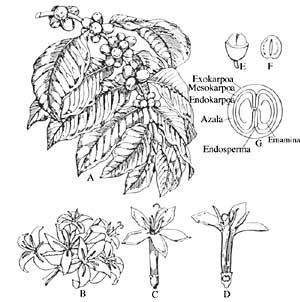
Process of elaboration
They take immature fruits and the seeds are released by dry or wet way. After 12-24 hours of non-alcoholic fermentation (in which natural components are altered), the seeds are dried in the sun and roasted. They lose water and the sugar is caramelised. The type of rotation depends on the temperature.
For the development of decaffeinates, caffeine is eliminated with organic solvents, using for it the robust C..
COCOA
Family Teobroma cacao Sterculariaceae
It has its origin in the Amazon, but also in the Mayan and Aztec cultures. Throughout the Colombian Andes it entered Central America, where it was planted by the Mexican Mayas, so cocoa can be considered as an old Central American cult.
Before the arrival of the Europeans, locals roasted seeds to produce a stimulating drink. Both the Mayas and the Aztecs made pasta mixing cocoa, garnish ( Bixa arellana ) and red peppers. When it cooled it was placed in a mold. Then their pieces were added to the temperate waters until it dissolves. Cristóbal Colomb (XV. In the nineteenth century, it brought this drink to Europe, but here, for its flavor, it was not successful. However, the Germans planted this tree in Curaçao and turned it into a different processing process in which they removed the fat, which resulted from the pleasure of the Europeans. Then the sugar was added and then it had a great success.
XVII. Until the eighteenth century Spain had the monopoly of cocoa, but in that century German and Dutch moved the plant to southeast Asia (Sri Lanka and Indonesia). Until 1900, 81% of cocoa production was obtained in America, especially in Brazil. However, with the abolition of slavery in 1951, it began to be planted in Africa. It is evident that 2/3 of the current production comes from Africa (35% from Ghana), the rest from South America and Central America, with lower production in Asia and the Pacific. Europeans consume half of their production and Americans consume 40%.
As with coffee, the main current producers are in foreign territories, always at the same latitude (Figure 4).
The cocoa tree (Figure 5) is one of the tropical territories, but does not require a specific dry season. The flowers develop in trunks, that is, it is the cauliflore. Its composition is adapted to the pollination by sits and butterflies and the fruits, of course, are hung from the stem.
Process of elaboration

The fruit is stripped and the pulp and seeds (20 to 60 in each) are fermented in 4-7 days. During this time, temperature, alcohol and acetic acid kill cotyledons and polyphenols become precursors of chocolate, passing the seeds of beige to purplish brown. At the same time the curd is paved by several micro-organisms. After the fermentation loses astringence and odors and flavors develop. The next step is to dry it to the sun. Then the seeds are separated and classified, tasting the flavor and smell. In this way they are almost ready, but they are still fatty acids. Finally, when chocolate arrives in the factories it is toasted and pressed, unpacking oils and fats (cocoa butter).
TEA TEA
Family Camellia sinensis Teaceae
Some believe that tea is the drug of half the world's population. For others, consumption is much lower. Tea cultivation was established 4,000 years ago in the East, where it was used as a medicinal herb. Later it was known as a drink and was transported from China to the rest of territories. From Chinese origin to Japan a. C. C. It was taken in the year 500, later to Mongolia, and by the time it arrived to Europe, XVII. It was a century. Europe became the main tea importer (England and Holland in particular). These last tea plants XIX. In the nineteenth century it was planted in the colonies of India.
Currently the main producers are Japan, India, Sri Lanka and Indonesia, which despite its large production in China, is used for consumption. Less important are the productions of Kenya, Zaire, Soviet Batasuna, Turkey and Argentina (figure 6).
The tea plant (evergreen shrub belonging to the species Camellia sinensis) (Figure 7) develops in acidic lands of tropical or high subtropical regions. For a good tea, the last 3 or 4 leaves of all branches of the plant should be taken, with a high content of polyphenol (25%) and caffeine (2, 5-5%). Once the leaves are collected, they are subjected to different procedures for obtaining black or green tea. Black tea (75% of what is exported) has a characteristic aroma and flavor by oxidation of polyphenols. The green is however.
Black tea process
After the collection of the leaves are oxidized in the shelves of the ventilated room for 24 hours. Then the leaves fall and break (the contraction is done by machine, but before it was done by hand), thus eliminating the essences present in the cells. These leaves are fermented later in a wet room, where they acquire a dark color and a characteristic flavor. The leaves are dried again, that is, the humidity is removed (up to 3%), which allows to control the action of the microorganisms.
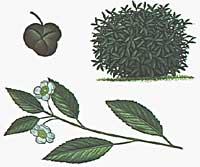
In green tea, the enzymes responsible for the oxidation of polyphenols die, drying the leaves in the ovens. Then they have a slower color and flavor. The type of tea that the Chinese and Japanese take is the latter.
MATE
Family Ilex paraguariensis Aquifoliaceae
It is a very widespread drink in South America. It is considered as a stimulating, digestive and nutritious drink. Native to the mountains of northern Argentina and southeast of Brazil. They take the leafy branches of the tree that after cutting them are thrown to the fire. Often the toast is repeated. The double toast is for Americans. The leaves are polyphenol and caffeine, but have less than tea. Neither is it so stimulating nor so astringent. The drink is taken heated.
COLA COLA
Family Cola nitida, Cola acuminata Sterculiaceae
It belongs to the same family as cocoa. The tail comes from the Western African tropics, especially from the states of Ghana and Nigeria. The seeds contain a lot of caffeine, teobroma and colamina. Therefore, they are stimulating to the heart.
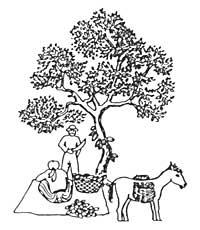
Although most of the perfumes and stimulants used for non-alcoholic beverages were initially extracted from the cola, at present this use is more discarded. However, in the territories of origin, at present, it is used as a drink after the cooking and crushing of the seeds.
The two mentioned species entered South America during slavery.
GUARANA
Family Paullinia cupana Sapindaceae
Guarana is the tail of Brazil. This drink has been traditionally used by the indigenous people of the Amazon. The seeds of this climbing plant are crumbled in water and mixed with the Sweet potato (Manihot sculent) is obtained the paste that is dried to the fire. Thus, the mass can last years. The pieces of pasta are dissolved in water (or in carbonated water) and becomes a popular Brazilian drink. Some polyphenols and oil essence give it a special flavor. Currently this drink has begun to be exported to other states.



